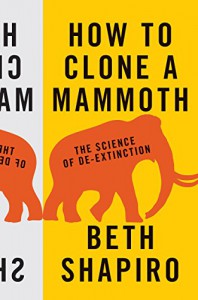1
Followers
30
Following
Silk & Serif
Silk & Serif a book blog developed by Debbie. We are dedicated to reviews, the book community and all things "bookish"! The main focus of the blog being Fantasy, Science Fiction, Romance and YA novels.
Currently reading
The Worst of Times: How Life on Earth Survived Eighty Million Years of Extinction
The Bourbon Kings
Smoke on the Water (Sisters of the Craft)
Seveneves
Wallbanger
The Last Archangel
The Maze Runner
Invaded
The Emperor of All Maladies: A Biography of Cancer
Never Cry Wolf : Amazing True Story of Life Among Arctic Wolves
How to Clone a Mammoth: The Science of De-Extinction
 I received this book via NetGalley from in exchange for an honest and completely unbiased review.
I received this book via NetGalley from in exchange for an honest and completely unbiased review.I want to start noting that I generally dislike the maltreatment of animals and cruelty enacted in laboratories, so this could not be an unbiased review.
How to Clone a Mammoth is about cloning and the various problems concerned with the technologies used to clone cells. Shapiro explains these problems in the most base way, only touching on much of the scientific jargon that would confuse the average reader. She also explains that cloning would not return a perfect specimen from the Ice Age as popular belief has led us to imagine. Instead, the creatures developed from cloning would be mammoth-like. These species would act to revive ecosystems by filling in the gaps where interactions between species has gone dormant due to the extinction of one or more animal.
Unfortunately, while the conservation of failing ecosystems is a valiant effort, Shapiro goes further by stating that we shouldn’t restrict this technology to de-extintion. In fact. she offers cloning technologies as a method to alter endangered species who lack diversity or cannot adapt to climate change quickly enough. The desire to play with the biology of struggling species is a cold, analytical leap in Shapiro’s logic. It describes the chilling future of this technologies and the lack of morality found in those wielding it.
On top of the desire to alter live species, Shapiro theorizes that if new species are created to fill ecological niches there may come a day when our creations may do more damage than good to the ecosystem we are trying to maintain. The shocking conclusion is that we should eradicate the species if it starts to harm the ecosystem only further destroyed Shapiro’s work. The death of living creatures should never be something brazenly thrown around. Although Shapiro highlights that there would have to be careful consideration this matter, and perhaps even a council should be drawn up to purpose such mass slaughters.
Shapiro covers back breeding as one method for bringing back the mammoth and outlines the struggle for recreating the auroch, they are creating new technologies to slip “scissors” into a nucleus to snip out the genetic code they don’t want, and plan to use “glue” to paste the new genetic code geneticists have created to make sure the new genetic code is fused. The techniques covered in this book are both cutting edge and leading back to the selective breeding practices to rebirth various animals: the Dodo, the auroch and Passenger Pigeon.
I also learned how an egg is made inside a chicken, chickens cannot be cloned, ancient DNA is much trickier than we can imagine, and Asian Elephants just might be the closest relative to the mammoth.
Although I abhor Shapiro’s ethical arguments I enjoyed her work. How to Clone a Mammoth was extremely educational for the average reader over a broad range of topics and it attempts to conquer very delicate moral issues. Although sometimes repetitive with ideas, this book is well worth a look for people who know very little about cloning and biology.













